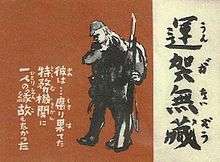Taro Yashima

Taro Yashima (八島太郎 Yashima Tarō, September 21, 1908 – 1994) was the pseudonym of Atsushi Iwamatsu (岩松淳 Iwamatsu Atsushi), a Japanese artist who lived in the United States during World War II.
Early life
Iwamatsu was born September 21, 1908, in Nejime, Kimotsuki District, Kagoshima, and raised there on the southern coast of Kyushu. His father was a country doctor who collected oriental art and encouraged art in his son.[1] After studying for three years at the Imperial Art Academy in Tokyo, Iwamatsu became a successful illustrator and cartoonist.
At one point both he and his wife Tomoe went to jail for his opposition to the militaristic government.[1] In 1939, they went to the United States to study art, leaving behind their son Mako (born 1933).[2] After Pearl Harbor, Iwamatsu joined the U.S. Army and went to work as an artist for the Office of Strategic Services (OSS). It was then that he first used the pseudonym Taro Yashima, out of fear there would be repercussions for Mako and other family members if the Japanese government knew of his employment.[2] After the war, he and his wife were granted permanent resident status by act of the U.S. Congress. He was able to return to Japan and collect Mako in 1949.
Career as illustrator
The New Sun, published in 1943 under the name Taro Yashima, was a 310-page autobiographical picture book for adults, about life in pre-war, statist Shōwa Japan. Its sequel, Horizon is Calling, published in 1947, was in the same format—usually one picture per page, with one or two lines of text. The 276-page tome continued the story of his life, this time with added Japanese text, and concluded with musings about leaving Japan to study art overseas. In both, he detailed his and Tomoe's maltreatment by the Japanese secret police.[2]
Yashima began writing and illustrating children's books early in the 1950s, under the pseudonym he had used in the OSS. The picture books Crow Boy (1956), Umbrella (1958), and Seashore Story (1967) were runners-up for the Caldecott Medal, later called Caldecott Honor Books. The annual award by professional librarians recognizes the illustrator of the "most distinguished American picture book for children".[3]
Yashima returned to his home village of Nejime, visiting childhood classmates and familiar scenes that he depicted in several of his children's picture books. He and filmmaker Glenn Johnson produced a 26-minute documentary in 1971, hosted and narrated by Yashima, entitled Taro Yashima's Golden Village.[4]
Personal life
The Yashimas lived in Los Angeles as of 1982.[1]
References
- 1 2 3 "Taro Yashima Papers". de Grummond Children's Literature Collection. University of Southern Mississippi. July 2001. Retrieved 2013-06-27. With biographical sketch.
- 1 2 3 Pulvers, Roger (September 11, 2011). "Taro Yashima: an unsung beacon for all against 'evil on this Earth'". The Japan Times. Retrieved 2011-09-18.
- ↑ "Caldecott Medal & Honor Books, 1938–Present".Association for Library Service to Children (ALSC). American Library Association (ALA).
"The Randolph Caldecott Medal". ALSC. ALA. Retrieved 2013-06-27. - ↑ "Taro Yashima's golden village.". Glenn L. Johnson. 1971.
External links
- Tarō Yashima at Library of Congress Authorities — with 21 catalog records